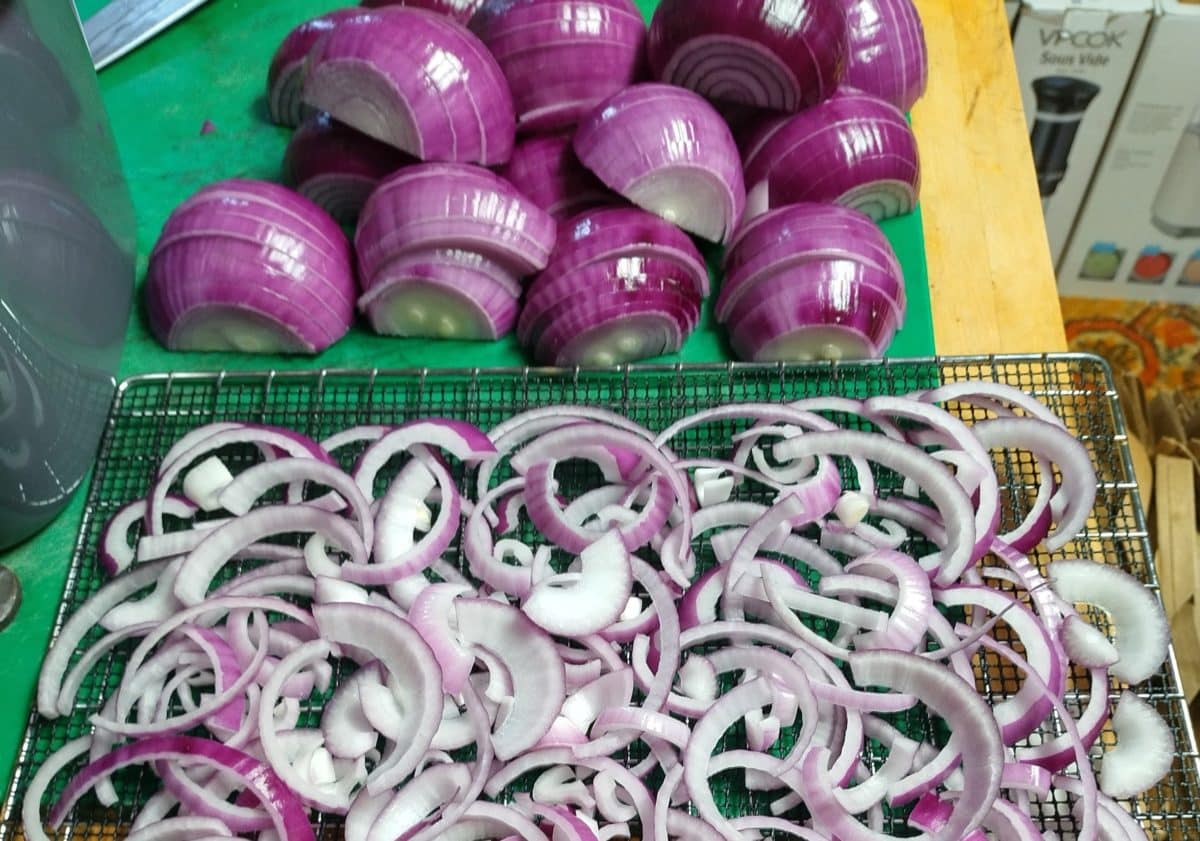“
In a time where just about everything is readily available off the shelf, we often forget the process of how farm to table works, let alone the actual work to get it there.
Growing and preserving garlic and onions. Advice for gardeners.
My Great-Grandparents Gift of Garlic
My great-grandmother grew garlic in California, and in 1947 visited her newly-wedded daughter and husband — my grandparents, Grover and Frances — in their new home in Washington state. She brought her poppy seeds and garlic as a housewarming gift. As far back as I can remember, my grandfather couldn’t get enough garlic and grew it in patches around the yard. Once I moved out of the house and had an apartment of my own, every Christmas I’d get a gift of a carefully braided cloves of garlic. When I purchased my first home, I planted that same garlic in the yard and shared with neighbors.
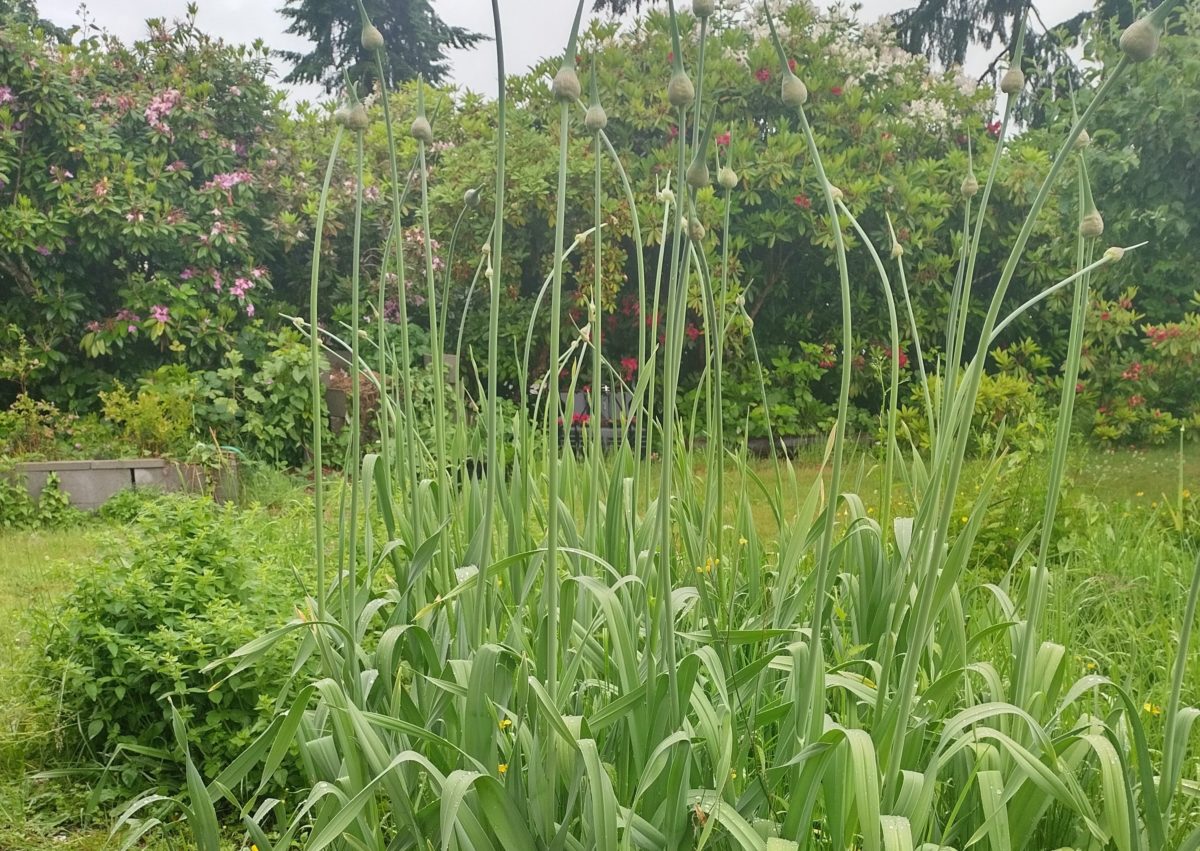
My grandfather was obsessed with the garlic. Every dish could have used “another clove.”
On the many trips back and forth between Washington and California to visit relatives, he picked up more garlic to plant. Through the years, his garlic has become unique, cross-breeding though cross-breeding. I brought samples to a Washington State University (WSU) Agriculture Extension for identification. There are many different kinds of garlic. Many have been lost and many hailed from Eastern European countries. In the 1950s, Elephant garlic was found in Oregon, in an old greenhouse. It was thought to be one of the lost varieties. It seems plausible that it was the garlic my grandfather bought, and cross-bred with the garlic my great-grandmother had gifted. Identifying this “new” garlic with the Master Gardener, we called it “Grover’s Garlic” in honor of my grandfather who tended it for so many years.
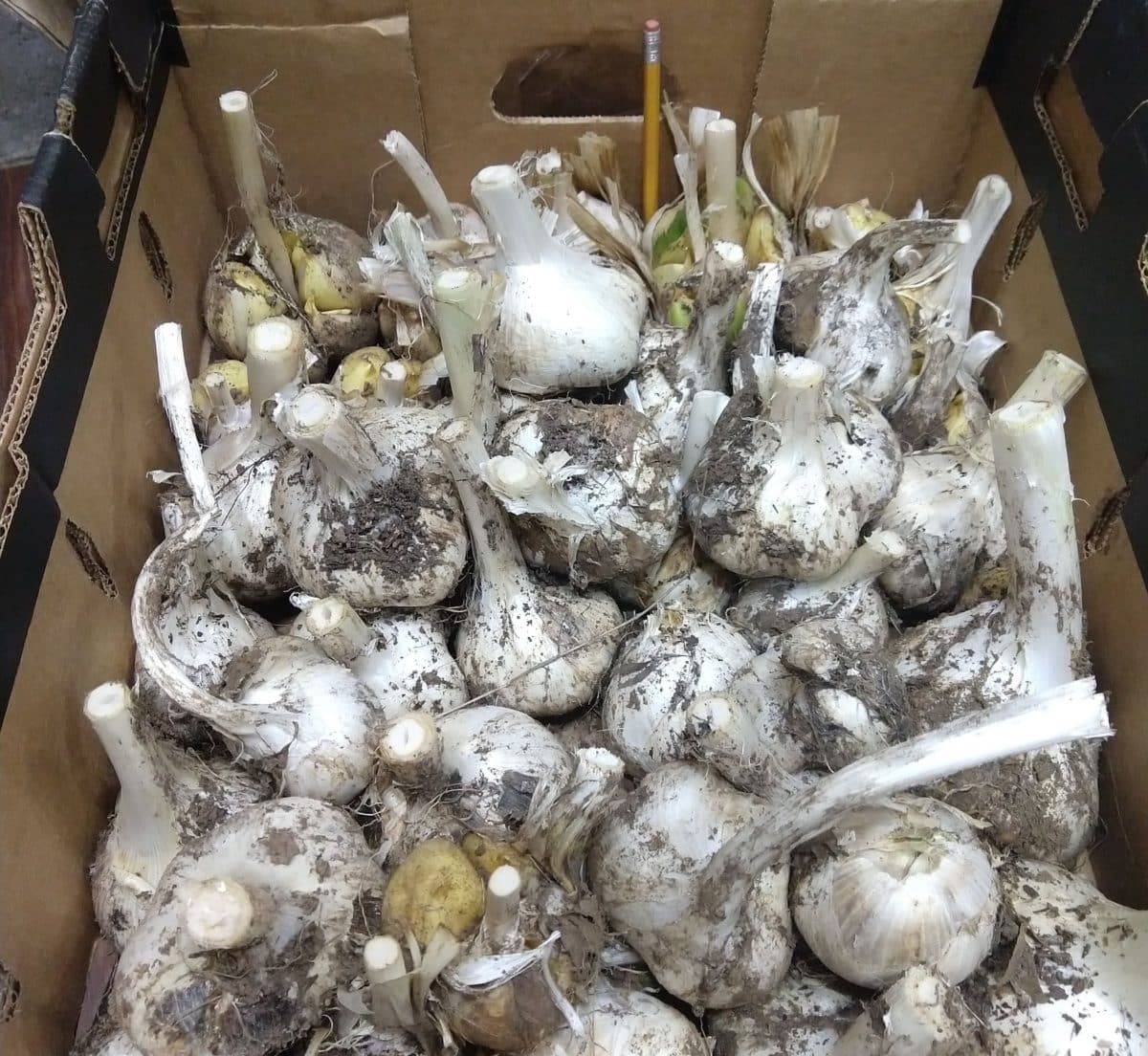
Today, I tend the garlic.
In the spring, to encourage a better harvest, I snip off the green stalks. Discarding the bulb that would have flowered leaves the edible stalk or “scape.” To dehydrate the scapes you must get them very early on. Otherwise they can become quite woody. The scapes can be used in the same way as garlic cloves, and even make a good green seasoning garnish for pasta dishes like Chicken Alfredo.
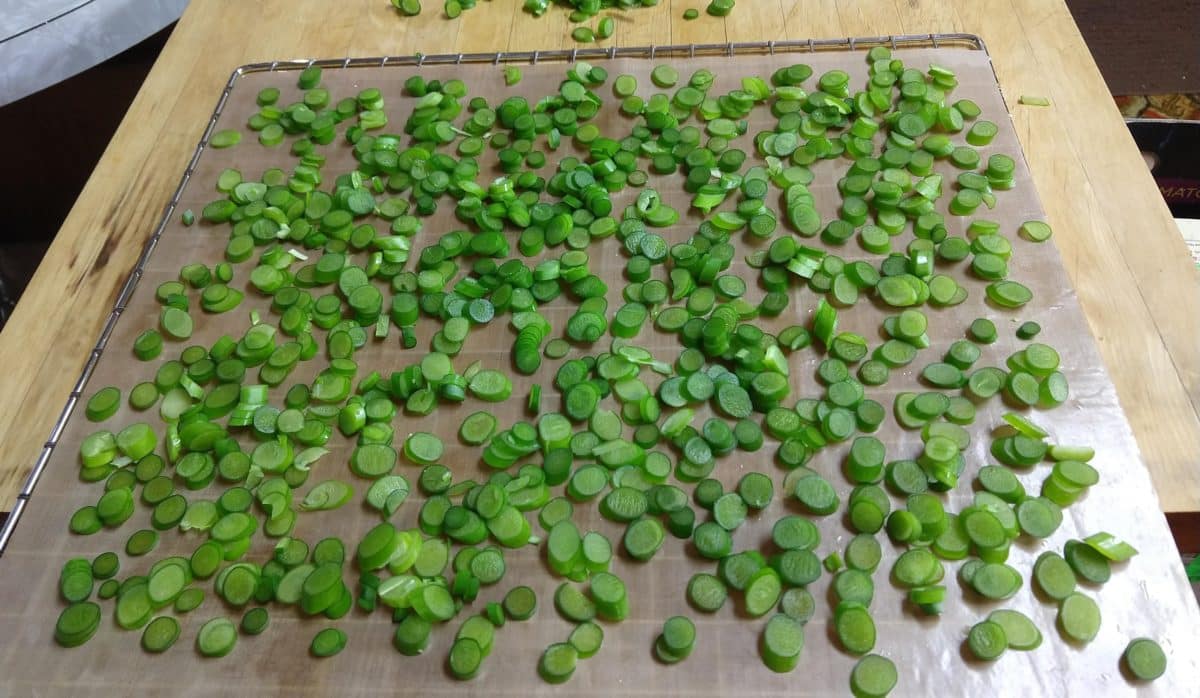
Harvest
Near the end of summer the garlic is ready for harvest. Since the bulbs grow underground they are often not apparent. Therefore one does have to dig with care. I will typically leave a few to flower, as the giant purple puff balls are fun to look at. And the local bees always seem most interested! Around the middle to end of August, I dig up the garlic patches and am rewarded with large healthy garlic bulbs. Those I had missed the year before, or let winter over, have odd, brown, large pea-sized things clinging to the bottoms of the roots. I use these to seed the patch over again. They can take a little longer than a planted clove to get going.

Preparing garlic
Sometimes I will keep about 8 cm (3 inches) or more of the stalk, and weave the bulbs together. Lately I have been getting a larger crop and have turned to dehydrating the garlic. I give the bulbs a good rinse, so not to be dragging bacteria from the ground through the garlic when I slice off the tops. Once the cloves are peeled, I mince the garlic. This shortens the dehydrating time and I also save small jar of fresh minced garlic.
A word of warning:
Improperly stored garlic can be a source of food born illness, such as botulism. If you are mincing garlic and storing it in salt water or oil in the fridge, please note that the commercial products you purchase use manufacturing techniques and processes that are much different!
I dehydrate the bulk of my garlic because it allows for years of safe storage and year-round use of what I have grown.
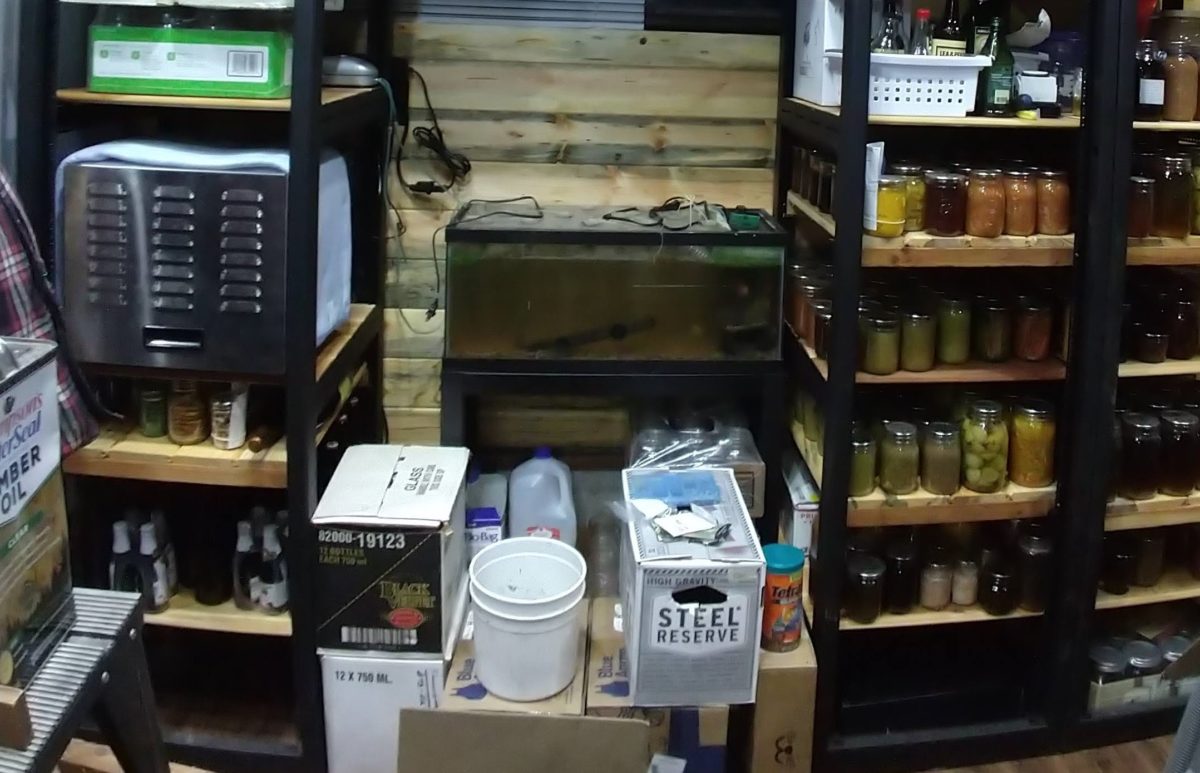
Dehydrating
Once the garlic is minced, I spread it out on dehydration mesh or mats, which keep the minced bits from falling through the mesh of my dehydrator trays. The minced garlic can be quite wet, creating a fluid or a kind of foam that dries during dehydration.
Some garlics, like Grover’s Garlic, will irritate your eyes much like onions do. They are a cousin to the alum, or onion, family. While this is just something that doesn’t bother me much, some of my friends have found it to be absolutely overwhelming (even those who weren’t typically bothered by slicing onions.)
I set the temperature of the dehydrator to 41-46°C (105-115°F) and check twice daily after the first day. I like to rotate the trays, being careful not to shake the contents, after the first day. I will pull them out and move the fronts to the back, and then the next day, moving bottom trays to the top. Check your owner’s manual for proper dehydration techniques.
Aside from the various options in dehydrators, there are alternative methods of dehydrating. Air fryers and toaster ovens may have a dehydration setting. Some ovens and convection ovens have a dehydrator setting too. (I’ve tried the using an oven on low and keeping it cracked open, but it didn’t fare well.) In the rainy Pacific Northwest, using the power of the sun can be difficult. With solar ovens, or even the old “put on the dashboard of your car” methods it is difficult to control the heat and humidity. I have considered purchasing a freeze dryer, but the price of additional “consumables” long term versus using the electric dehydrator with fan doesn’t add up. Make sure you know what your needs are.
Storing
It is easy to tell when the garlic is dry; the bits will be difficult to snap, like an uncooked grain of rice. The edges are sharp. Typically I empty the trays from the flexible mats, into a very large, wide stainless steel bowl. I scoop it into canning jars packed to the bottom threads of the jar, leaving roughly a 2.5 cm (1 inch) headspace, and vacuum seal. This is not a processed jar of garlic, nor is it preserved by canning. It is dehydrated garlic and the vacuum sealing helps fend off moisture. However, spoilage can still occur if enough ambient moisture in the air is present or the dehydration process allowed moisture to remain.
Garlic processed this way may last for up to 2 years. But I haven’t had any last that long on my pantry shelf to find out for sure! I did have one large jar of dehydrated garlic I used for cooking last a year, but one anecdotal story doesn’t hold up well against good food science.
I did try grinding the garlic into a powder, and storing it that way. I found this did not work very well. Commercial powders off the shelf have more than just “pure garlic” in them; mostly, some kind of anti-caking agent! Typically, that is in the form of salt (i.e. garlic salt) and I found that my little pint jar became filled with these garlic balls the size of pea gravel. Not as hard as pea gravel, but the point of having garlic powder is that it easily blends into the dish you’re preparing or seasoning. By storing it minced, most of the work is already done, and it can be reconstituted with water or liquid within the dish. If I want powder, I use a mini blender to quickly grind a small batch of powder to use before it begins to clump, or as part of a seasoning mix, say for a rub or sausage making. When frying up ground meat for tacos, I simply sprinkle in the dehydrated mixed garlic, and unlike fresh minced garlic, it will withstand a long cooking process and avoid burning and scorching.
Onions
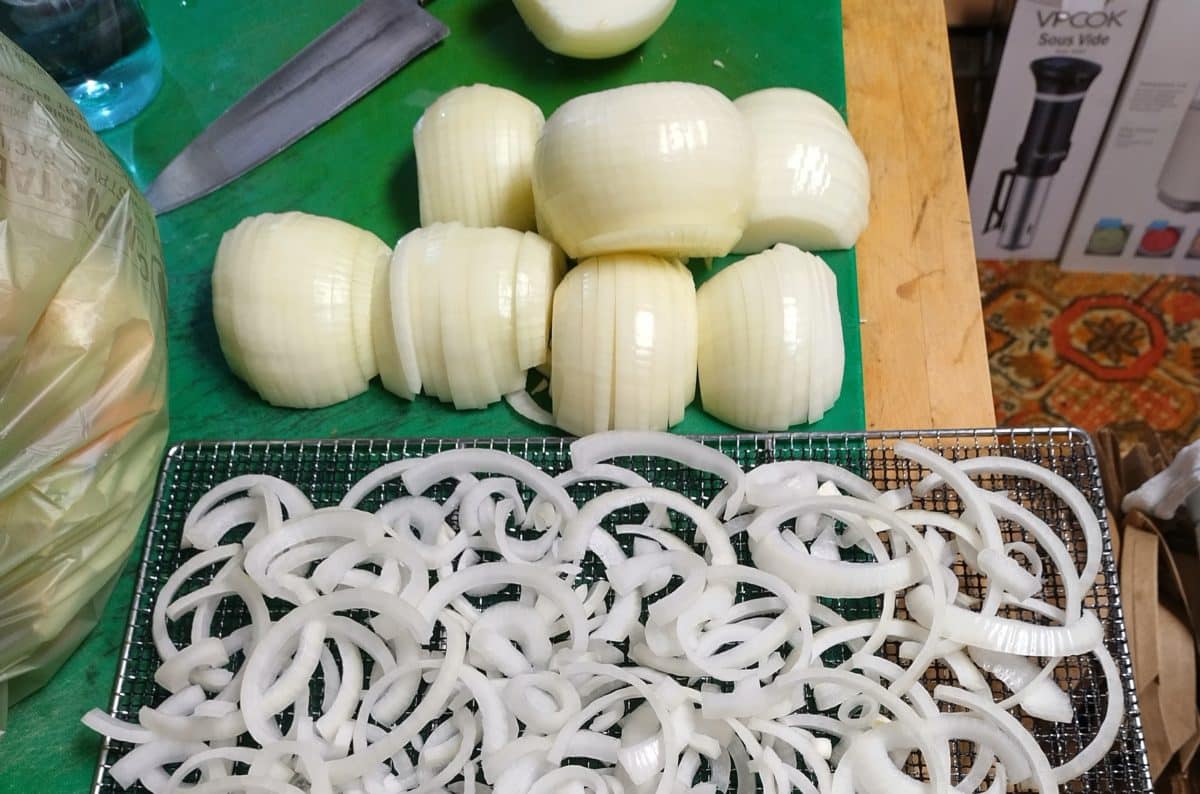
The environment in which the onion is grown affects its flavor.
The terroirs for onions, like those of grapes for wine, can, and do determine specific varieties in the regions where they are grown.
While the most common types of onions are sweet, white, yellow, and red, some lend themselves better than others for dehydrating. A lot will depend upon your culinary uses, whether making your own powders for seasoning or adding to soups, stews, and curries.
I’m fond of sweet onions, and being from the great state of Washington, am familiar with the Walla Walla sweet onion. A southern cousin is the Vidalia sweet onion from Georgia. At a local produce stand in Yakima, Washington, I discovered the tasty Candy Sweet Walla Walla Onion, which is only available at certain times of the year.
Storage
Most retailers sell onions, that, like apples have been stored for many months in warehouses.
Methods for preserving onions include drying them in a dehydrator or in the sun, storing them in a root cellar with stalks braided, or removing the stalks and suspending them in ventilated bags. Additionally, onions can be canned with other vegetables, as when making bread and butter pickles, or used in foods to be frozen or canned, like French onion soup.
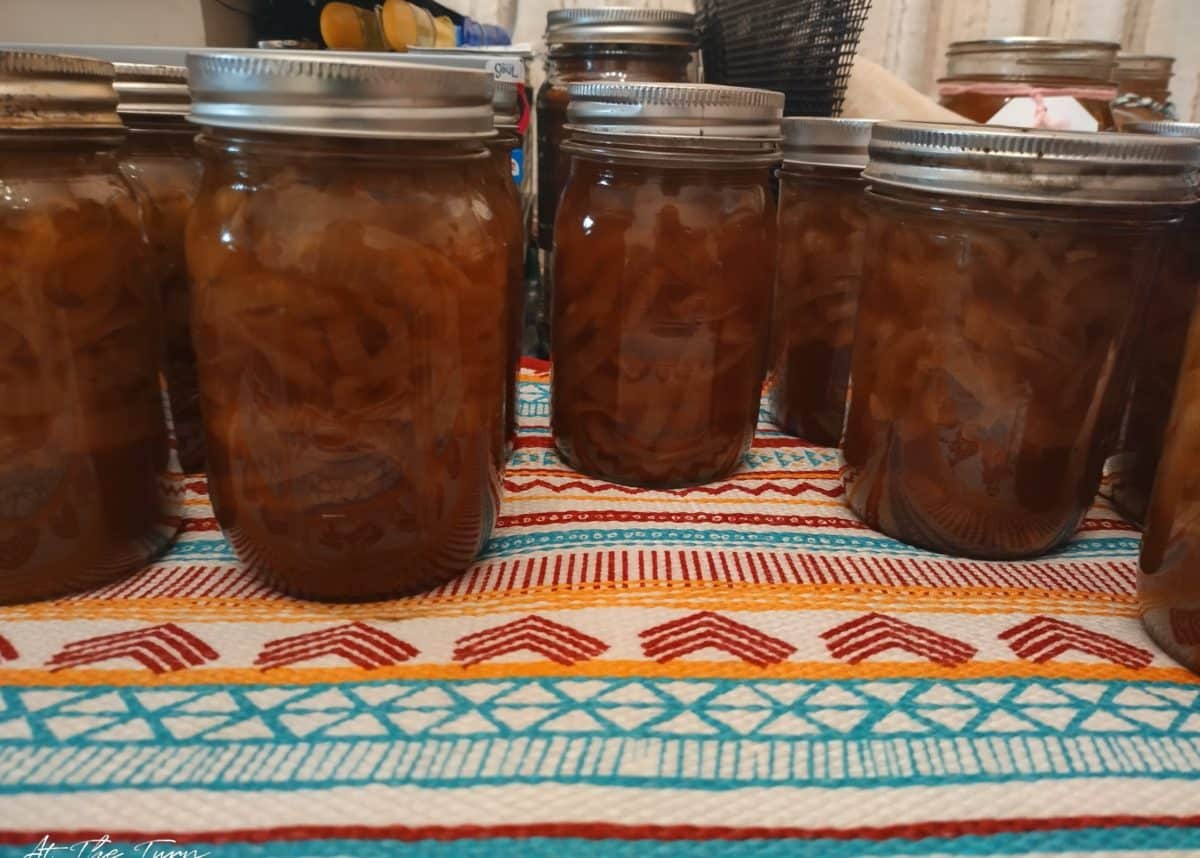
As with garlic, there are various means of drying onions. I like using a dehydrator. I often buy a 9 kg (20 lb) sack from a produce stand, and process them by simply slicing off each end and bisecting, then peeling off the outer paper layers. I use a sharp knife, avoid using a mandolin, and take breaks as needed. I also find putting the halved onions into a bucket of cold water helps. By the time I have peeled enough to fill up the trays, I pull the halved onions from the bucket and slice nice rings to spread out on the trays. I set the dehydrator to 52°C (125°F) and run it for roughly 9 hours. I have my dehydrator in the garage, so not to fill the house with fumes. I have the metal shelves in the dehydrator, as they do not absorb odors. With plastic shelves, washing with mild soap and water, with lemon juice or vanilla extract in the rinse water helps remove lingering scents.
Once the onions are dehydrated, you can check to make sure that they are pliable to crumbly. They may have some bend or give, but should not be sticky or rubbery. I store them vacuumed sealed in recyclable mason jars. Vacuumed sealed plastic bags work too, but with the jars I find I can better visibly check for moisture. Dehydrated sliced onion really packs flavor and sweetness. I also crush the dehydrated onion into flakes or bits to make seasonings. And lastly, I grind some into powder for making seasonings I know I will use quickly. Unless you add in an anti-caking agent or something like salt, the powders tend to clump up in storage. Sweet onion powder in pizza dough adds quite a unique burst of flavor.
A quick note on vacuum sealing jars
This is not a substitute for proper canning methods. If vacuum sealing powders, be sure that the rim and lid are free from powder, and only do a couple jars at a time. Also, be sure to label the jars with the date. While dehydrated goods store well, over time they do diminish. Rotate the stored goods so as a new batch goes into storage, the oldest are used first. ![]()
